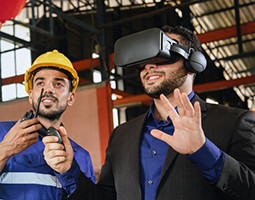June 03, 2024
Five truths about the retail store experience
Retailers have more options than ever before for creating a compelling store experience. Here are five key areas to focus on.
It goes without saying that customers must be at the heart of everything retailers do. Serving shoppers' needs through innovative and engaging store experiences is the key to expanding retailers’ reach, relevance and revenue.
Less talked about, however, are five other best practices that are essential for the retail experience. By embracing these five truths, retailers can thrive in this challenging, complex and continuously evolving landscape:
1. An independent shopper journey drives significant revenue impact
In retail, personalization isn’t just a way to connect with shoppers and build loyalty; it’s also an essential element for creating an independent shopping journey. By enabling customers to move seamlessly through the shopping experience—from finding products to understanding pricing and completing checkout—brands can empower customers to navigate the journey on their own terms.
For example, integrating QR codes within the store can enable customers to find out more information about the product, conduct quick comparisons or read customer reviews. Another example is frictionless checkout. Both are important features that can help customers make a decision and drive conversion in the store.
The fact is, not only do customers want these features, but these solutions can also have a significant, positive impact on sales. In a survey of US consumers 87% of shoppers said they would prefer to shop in stores with touchless or robust self-checkout options. Meanwhile, the Seattle Seahawks reported an 85% increase in transactions and 112% increase in sales per game after adopting a contactless purchasing technology.
2. The key to customer engagement is associate engagement
Retailers face an incredibly challenging labor market. Overall costs are up, talent is in short supply, and turnover is rising. With the estimated cost of rehiring and training a typical front-line retail store employee averaging more than $3,000 per person, it’s more important than ever to attract and retain great workers.
One of the reasons turnover is such an issue for retailers is because in-store employees are feeling the burden of the shift to omnichannel. In-store employees are tasked with traditional customer service activities, as well as managing new responsibilities, such as fulfilling click-and-collect orders or dispatching orders placed online. This ever-expanding to-do list is fracturing the employee experience and potentially taking time away from their most important task: engaging customers.
Labor management tools have become an effective way for retailers to add structure and focus to the employee experience. For example, Some retail store management solutions enable companies to connect teams, workflows and systems to help managers easily assign and monitor tasks across teams and respond to issues as they arise.
Meanwhile, on the employee side, use of these tools and systems can make day-to-day responsibilities easier and more intuitive. This is essential to increasing productivity, boosting morale and ultimately combating turnover.
3. To be on the cutting edge, take your data to the edge
The data companies use to make decisions matters. And sometimes it also matters where that data is stored.
Many retailers are seeing a real value in leveraging edge computing across the enterprise. By moving the computational power closer to the source, whether that is the store, distribution center or other facility, retailers can make accurate decisions, faster—all while potentially operating at a lower cost.
Edge computing also plays a role in other store modernization efforts. For example, companies are seeing an opportunity to use cameras and computer vision, in conjunction with edge computing, to dramatically strengthen loss prevention. These solutions can also be used to monitor store shelves, automatically detecting when an item on the shelf needs to be restocked.
4. Technology is integral, but it’s not immutable
Technology plays a critical role in making the retail store experience more inviting and engaging. This means retailers need to be creative and flexible about using technologies in different ways over time to support more advanced use cases.
An example is RFID technology. RFID solutions can play an essential role in resolving a common pain point in buy online/pickup in-store experiences: locating the item once it’s shipped to the store. Warehouse and e-commerce fulfillment solutions use RFID technology to accurately pinpoint these items, ensuring the order can be processed as promised.
But RFID technology can also be applied to other areas of the business. It can be used to support loss prevention efforts, optimize the supply chain, automatically replenish inventory or trigger personalized marketing efforts. This is a great example of technology that serves a multitude of purposes, depending on the needs of the retailer and the challenges needing to be solved.
5. Fight complexity with unification
The customer may never see the back-end systems powering the retail experience—but they certainly feel their effect when they hit a snag in the shopper journey. The key to a connected, cohesive and quick customer experience is ensuring that every digital solution and infrastructure component—be it on-prem, in the cloud or at the edge—is integrated.
Historically, retailers implemented distinct solutions depending on what they needed at the time. As a result, retailers often had separate solutions for their backend, order management and point-of-service needs.
Today, however, commerce solutions are increasingly unified end-to-end, which effectively reduces the number of devices and applications store associates must interface with. The result: Improved employee morale, streamlined operations and faster customer service, which is a win-win-win for retailers, associates and customers alike.
Where to start with the retail store experience
If you’ve been to a retail trade show this year, you’ll know there is no shortage of innovation in this industry. In fact, the issue for most organizations isn’t a lack of inspiration, so much as knowing where to start.
By taking these five actions, retailers can ensure they’re delivering on what customers want, and reap the reach, revenue and relevance benefits that will propel them successfully into the future.
Rob Johns is the North American Retail Commercial Head for Cognizant’s Industry Solutions Group. Rob has 20+ years of experience working directly in the Canadian retail industry and 18+ years of experience in retail consulting.
Latest posts
Related posts
Get actionable business Insights in your inbox
Sign up for the Cognizant newsletter to gain actionable AI advice and real-world business insights delivered to your inbox every month.
















